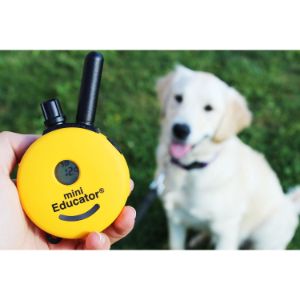
You’ve heard of shock collars even if you’re not a dog owner. More often than not, you’ll ask the question, “Can a shock collar hurt a dog?” Sadly, that question cannot be answered with a simple Yes or No.
Because there are different kinds of them out there, each dog reacts differently to them.
Some dogs will yelp at static stimulation that won’t bother you, and some dogs, even those you perceive as gentle or sensitive, won’t bat a doggy eyelid at electric shocks that would make your entire arm twitch.
If we focus on the objective parts, you’ll find that most collars don’t disclose the statistics of the shock. No watts, no amps.
There are no videos of anyone using a multimeter or some tester, but there are videos of us humans trying out the collars on ourselves for entertainment. With that said, we can ask the question:
Other articles you would like: Mini Educator E-Collar ET-300 – Review & FAQs and 8 Effective Solutions To Stop A Dog From Jumping A Fence
Table of Contents
What Does a Shock Collar Feel Like?

If you’ve seen or tried muscle stimulators like the ones that promise you a six-pack in six months or the ones that help with physical therapy, then that’s exactly how electronic collars work.
They still deliver an electric shock, but it’s both incredibly weak with some feeling like a mild tingle, much weaker than the typical static shock you get from walking on a carpet with socks.
Furthermore, shock collars do not deliver a continuous stream of energy. Instead, it delivers rapid millisecond-short nicks, which means the energy does not ramp up.
The effect could be tingling sensations, very slight pulsing or tightening of the muscles, or twitching of the muscle groups where the shock flows.
It’s not enough to cause hot temperatures, and even if you held the continuous shock, most, if not all, modern e-collars have a 7-10 second limit, then shuts the shock off even if you keep pressing.
Is a Shock Collar Cruel?

At least here, we can say that modern shock collars are not cruel, at least on their own. Shock collars from the 1950s, though can be considered absolutely cruel.
Back then, these training tools didn’t have a way to control the shock levels and were purely used for hunting dogs. Research on using the shock collars was in its early stages too, and so was the training method.
Since it’s used for punishment and little-to-no shock strength control means, it was a cruel device by today’s standards.
Today, the modern electronic training collar has shock control, sometimes having 100 intensity levels.
The shock is also weaker and we have proper training methods to help reduce unwanted behaviors. However, that does not keep people from using it for cruel purposes.
We can argue now that modern remote training collars produce an annoying sensation at worse, but anyone misusing it will likely end up doing something cruel to their dog, sometimes without them knowing.
That’s why there’s plenty of media out there showing how to properly train dogs using electronic collars, and some online stores offer training manuals, both video and articles.
You don’t need to be a professional trainer to use the shock collar; all you need is to do a bit of reading and a good few sessions of practice.
So, in conclusion, does a shock collar hurt a dog? No. It’s a misuse of it that hurts them.
If you shouldn’t use a shock collar because of the alleged intense shocks, then even a budget-friendly shock collar has non-shock modes, such as a vibration feature.
Some even have two rotors and no shock. Make no mistake, though, even those who only use vibration can still cause the same “burn hole” damage some people get when they use the ones with shock. How could that happen?
Are There Any Shock Collar Side Effects?

When misused, you will get many problems, such as the cons of shock collars and other training tools. We’ll show you what problems you may face and how to avoid them because prevention is better than cure, like medicine.
Hole marks where the prongs are pressing, which sometimes lead to infection and bleeding
Some people mistake these for burn holes. There is a chance they could be if they used a cheap e-collar that malfunctioned.
99.99% of the time, these holes are ulcerated pressure sores, meaning something pressed on the skin so much that the pressed skin died and made a wound. Bacteria then enter the wound and cause a spreading infection.
Causes:
Two things: The owner put the flat collar on too tightly and had the dog wear it for an extended period, often days without removing it. Vibration collars are more susceptible to it because the friction created by the vibration can add to the effect.
Prevention:
When placing the flat collar, tighten it only to a point where you can comfortably but snugly fit two fingers (three if you have small hands) between the neck and the neckband.
You can loosen it a bit more if you’re using longer metal prongs. Afterward, never keep it on for more than 8 hours, and if you can help it, reposition the receiver or training device to another side of the neck or vocal cords.
Optionally, you can purchase silicon caps for the prongs. These do not prevent pressure sores entirely, but they do increase the surface area a little more, giving you more time before the pressure sores occur.
Your dog is scared out of its wits during e-collar training or just wearing the collar, and/or develops aggressive behavior
Some would attribute this to the painful shock they experience in e-collar training. There is a possibility this would indeed be the case, but not because the shock collar was producing the powerful shock. It can, but it’s not the chief reason.
Causes:
Using the shock collar for punishment and overcorrection. Some owners use shock to punish their dogs while in the middle of undesirable behavior, like chewing on furniture or jumping on visitors.
This causes them to develop a phobia. Now they are afraid to act because they think they could get shocked.
As for overcorrection, sometimes owners may use a much bigger electric shock than required or get frustrated at their dog during training that they shock them for much longer. Some owners also, unfortunately, use a higher level of shock on punishments.
Prevention:
Realistically, there are only two times you should activate the electrical shock: During negative reinforcement, you will activate it upon stating the command and release it when they do it.
The second one is when you need to grab their attention when they are performing unsafe behavior, such as running into a busy street or about to get into a fight.
Always use the lowest level your dog will respond to. You do this by setting the level of shock to the lowest, then triggering the shock. If your dog reacts in the smallest ways, stick to that level.
Otherwise, raise the adjustable shock levels by one and try again until you get a tiny reaction. After a week or two, try to find the lowest shock level again.
Finally, never use any aversive training methods on their own, like when using pinch collars or even a martingale collar.
Shock collar training and any other aversive behavior modification should be accompanied by positive reinforcement methods like high-value treats your dog will never say no to, lots of praise, and you are displaying positive behavior during training.
Other Questions People Asked about E-Collars

- Can you use a shock collar on a puppy?
The earliest you should use one is when they are six months old and are at least 10-15 lbs heavy, as their average neck size should be sufficient.
They are at their 2nd “Fear Phase,” which makes them more responsive to training, but any older than that is still okay. Some work dogs are 6 months old when they start with shock collar trainers.
- Can a shock collar kill a dog?
No, not, not even accidentally. The electric shock is not even as strong as prank shock toys.
They can cause great discomfort in the hands of a neglectful owner but never death. If there was, it was done with deliberate malice, as it would take great effort to kill with such humane training tools.
- Can you do dog training with dog collar shock while pregnant?
No. If you have to train an expecting canine mother, use vibration instead. If you’re the pregnant one, training a dog is decent exercise.
- Are there other kinds of electronic dog training collars?
Citronella collars, a.k.a spray collars, use a diluted citronella solution. It’s an alternative to shock collars, but usage of this requires precise timing to effectively use because otherwise, usage of it counts as punishment.
Citronella is irritating to dogs and cats, so if you plan on using one, use it sparingly, just like most punishment-based aversive behavior modifications.
Others are electronic fences and Anti-bark collars. They operate the same way: giving a beeping warning first, and if the wearer either stays close to the wired or wireless fence or keeps barking, only then will they deliver a shock.
The goal is to stop excessive barking or crossing the invisible fence when they hear the beep.
- How do I tell if I need a shock collar for my dog?
In reality, you don’t need any training tools, just humble treats and praise. A positive reward is sometimes more than enough. Some dogs react better to it than others.
In some cases, dogs are either too smart or stubborn to change their ways even after weeks of training, which is why some pet parents employ tools like an electronic training collar.
Using this requires that you do your homework on how to use it, so make sure you’re already familiar with the basics before purchasing one.
- Where can I learn e-collar training?
Plenty of articles and videos are out there teaching you how to use a training shock collar, especially how to use them to reduce undesirable behavior.
For beginners, it’s best first to practice basic positive reinforcement training methods. It’s simply rewarding your dog as soon as they did the command well.
This way, you get to teach and familiarize them with all the positive behaviors you’ll eventually reinforce using the shock collar, and you get to practice the timing.
The training process of negative reinforcement requires some finesse, so it’s best to master the other half first.
Does a Shock Collar Hurt a Dog?

Any tool in the right hands can make great things. Just ask chefs who wield knives whose edges are often close to razor-sharp.
Shock collars are training tools and, in the right hands, can train dogs to have a more harmonious relationship with their owners.
As long as you muster up the patience, do your homework, and, above all, use the training tool with the utmost respect for your canine companion, even if you make blunders here and there, you’ll end up improving both you and your dog’s life in the long run.
You will also like:
- Boxer Ear Cropping – What To Understand Before You Decide
- Dog Corn Cobbing: Reasons Behind The Behavior & What To Do
- Can Dogs Eat Swedish Fish?
For more information about E-Collar Dog Training, check out the video below:




